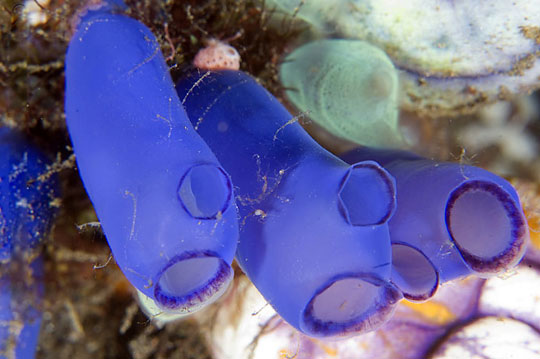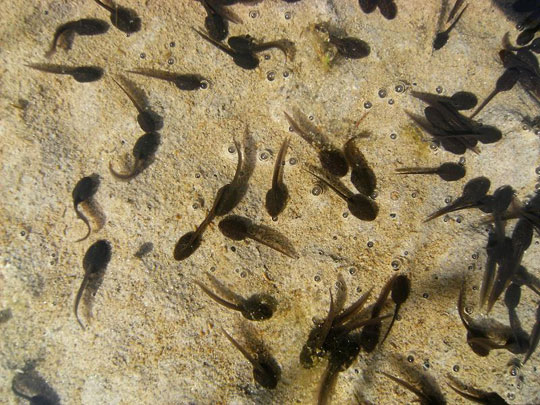In the natural world full of dangers, the ability to transform spectacularly of the following 'mutants' is indeed an effective 'way', not only helping them evade enemies but also actively supporting them. in earning a living, maintaining the race, and surviving in a fiercely competitive environment. Sea squirt

Common marine species often cling to hulls or other objects such as rocks or corals. Although it is an animal, it looks quite like plants with its body without a clear shape, often with spherical or cylindrical shape with colorful colors. On the outside of the body there was a transparent coat covered.
A marine species is a species that can change quite strongly from larval stage to adulthood. Seaweed larvae have a brain, a spinal cord and tail - a structure similar to those of higher animals; however, when they begin to mature and stick to a certain object, these parts will gradually disappear according to the growing process of the pepper. The sea also has the ability to self-heal wounds by regenerating new cells. This strange creature is still attractive to scientists. They are investigating its ability to heal its wounds, thereby finding new ways to treat cardiovascular and Alzheimer's diseases in humans.
Tadpole

Tadpoles are the larvae of amphibians such as frogs or toads. When these tadpoles develop into adulthood, their bodies will change spectacularly, leaving no trace of the previous stage. When they were larvae, or they used to be called tadpoles, they lived in shallow waters, and the body did not have any extra parts except the long tail. But to the stage of adulthood, the tail starts to digest itself, and the limbs also begin to develop. The mouth gradually spread out, making the head follow it and expanding. The internal organs also change to adapt to a new diet - from the predominantly plant-based menu, they now switch to consuming all kinds of insects.
Chameleon

Chameleon is famous for its ability to change body color according to the color of its surroundings, however, according to researchers at San Diego Zoo, they don't mimic every color. The ability to customize body color according to the color of the chameleon environment is due to a 4-layer skin texture. Each skin layer contains a different pigment, allowing other skin layers to vary depending on the intensity. light, temperature and humidity in the air. In addition, nerves and hormones also participate in this unique color-changing magic. Chameleon not only uses this camouflage ability to hide wild predators, but it is also a form of expression of their mood.
Owl

There are about 45 different species of owl in the world, most of them live in Africa and southern Europe. Cat owl is a nocturnal species. With a small body (only about 17 cm) they are easy to turn into snacks for other birds of prey. So this clever bird used a trick to protect itself. Thanks to the bristling coat that resembles a bark, the owl easily hides and blends into the surrounding scenery as they perch on tree branches; In this way they become almost invisible in the eyes of other predators. In addition to this camouflage ability, the cat has another way of pulling the body to relax so that the body looks thinner, and when it sways its body, it looks like a branch is swaying in the wind.
Caterpillar

Caterpillars are probably a transformation in nature, from pretty scary worms that become a charming, colorful butterfly wings. But that is not the only possibility of this species; thanks to their color, they can disguise their tea in the surrounding trees, their feathers look like spikes on a tree branch. Thus they can survive until fully mature and begin the transformation process. The beginning is the stage that turns into a pupa when the worm begins to fix itself into a certain body like a bark. They will then create a cocoon. The transformation happens silently inside this cocoon, in which the caterpillar gradually decomposes into a liquid, leaving only a few cells left to shape a butterfly. At the end of this process, cocoons cracked and butterflies spread out to start a new life. Because only a few weeks lived, they took advantage of time to mate and lay eggs. Eggs hatch into larvae, and a new life cycle begins.
Arctic Fox

This fox lives on the cold Arctic tundra; they have a special ability different from their relatives, which change the color of the coat to make it easy to mix with the environment. At the beginning of spring, the thick white fur of winter will be replaced by a shorter brown coat, so that they blend with the color of the dirt and the forest carpet. Then in November every year, this brown fur is completely renewed with a thick, white fur ready to welcome the snowy winter. Thanks to the ability to change fur in this season, the arctic fox can catch the eye of other great predators. This fox is also very clever, they often follow the polar bears, wait for them to finish eating to enjoy the leftover food; thanks to the white fur mixed in the snow, they were not turned into the next meal for these bears.
Tiger salamander

This is the largest salamander in the world; Call them tiger tigers because of the patterns on them they resemble the patterns of tigers. This salamander species grows to 35 cm long in adults and has yellow stripes or spots on it. The salient feature of this species is that they can be cleverly transformed while mating with females to be successful in maintaining the race. In the breeding process of this species, the male will release a sperm pouch to allow the female to swallow. When a male cannot find a partner, he will use another '
trick ' to be a father. This time, it will pretend to be another female to approach the lovers. The fact that she was pretending to be a child would make the male not be wary of its presence; then the fake will put his sperm bag on top of the opponent's sperm bag, and then the child will choose this bag of this guy.
Flounder

This fish has an ability that other fish cannot do, it is swimming in a horizontal position. More particularly, their eyes are on the side of their body, facing upwards, while the face facing the sea floor has no eyes at all. In fact, at a young age, their eyes are also symmetrical on both sides like other fish, but the bigger the eye the other side moves upwards, and this makes them an exception. of symmetrical rules on both sides. They also have the ability to change body colors to match the colors of the sea floor to the eyes of other predatory fish.
Longarm octopus

This is the most mischievous person on the seabed with the ability to transform itself into the shape of many other species and mimic their behavior to camouflage escape. Upon discovering the enemy, they quickly put their tentacles to mimic the shape of other species outside of the predator's favorite menu; for example, it can mimic the shape of flounder, or turn into a sea snake, so that through the eyes the predator likes the octopus. It even imitates the behavior of the animal that it is disguising. Although this "
period " does not completely conceal our octopus, it is enough to distract the predator, so that this talented magician has enough time to slip away.
Stick insect

If you don't see them moving, you probably won't know it's an animal, because it looks like a soggy wooden stick. Their ability to disguise is so ingenious that they don't even lie in the trees that can appear anywhere confidently. Even their movements make you think that it's a small branch that is swaying in the wind. This ingenious animal also has special reproductive properties, both asexual and sexual. If an unfertilized female lays eggs, these eggs will hatch into female beetles; if a male fertilizes an egg, it will hatch into a male bug.










 Animal 'suffering' after hibernation
Animal 'suffering' after hibernation Why do goats climb well?
Why do goats climb well? Scientists were surprised to see chimpanzees eating turtles
Scientists were surprised to see chimpanzees eating turtles Giant catfish died deadly due to drought in Thailand
Giant catfish died deadly due to drought in Thailand